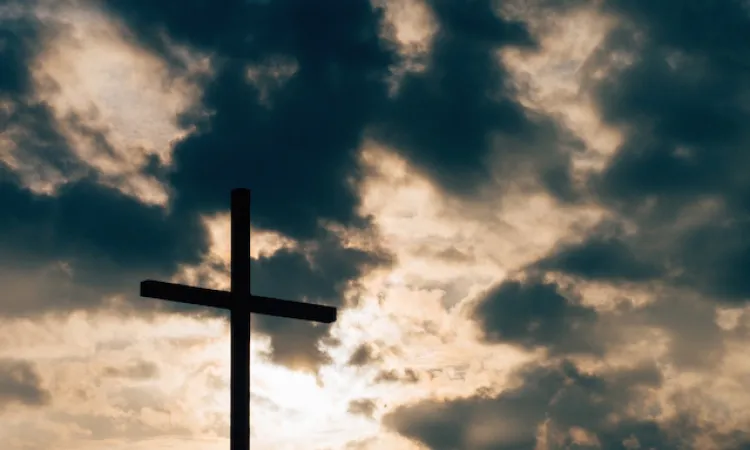These approaches of integration enter into positive dialogue with scientists, philosophers, artists, politicians, and others who do not share a religious belief. Integration manages to appreciate their way of understanding and explaining things. Yet, while the principle of causality is at the heart of all matter, it cannot directly prove the existence of a personal God. Father Michael Buckley, S.J. opines that it is more beneficial to the atheist and the Church if appealing to the contemplative-kerygmatic approach precedes abstract philosophy (Ibid., 29-30).
Fourth Strategy to Address Atheism: Double Conversion
For theologians like Richard Niebuhr, Henri DeLubac, and Hans Urs von Balthasar, atheism implies a double distortion, a distortion of the natural and supernatural orders.
The first conversion, the horizontal level attempts to convince the atheist that religious belief in Christianity does not go counter to men and women; it does not belittle their dignity nor does it hamper their freedom. The message of Jesus brings and develops light, life, and freedom.
More in The Way of Beauty
Christianity is intended to underscore one's ability to realize and make room for transcendence, both horizontally and vertically (Ibid). For the natural order of things, von Balthasar offers first a statement and then a series of questions:
There is an I, and there is a you. Who is this person within who says I? What am I precisely? Am I pure chance? Why am I I and not you? Not merely why, but that I am? Why do you love me? Why me? If I do the things I shouldn't do, and don't do the things I should-am I not a riddle unto myself. Doesn't someone owe me an answer for this contradiction within me? On the positive side of things, my spirit has been bestowed from outside of me. In happy amazement I can experience myself deep down immersed in my heart, my imagination, my feelings, my emotions, my moods (The Von Balthasar Reader, 59ff).
Von Balthasar quotes Blaise Pascal who casts the riddle of the self in his own way: "What sort of freak then is man! How novel, how monstrous, how chaotic, how paradoxical, how prodigious! Judge of all things, feeble earthworm, repository of truth, sink of doubt and error, glory and refuse of the universe! Who will unravel such a tangle! . . . What then will become of you, man, seeking to discover your true condition through natural reason? . . . Be silent. . . . Learn that man infinitely transcends man. (63; From Pascal: Pensées, 1966 trans. A.J. Karailaheimer, 64-65.)
"God Is Inescapable"
Henri De Lubac observes that "man cannot get around God, cannot do without God; God is inescapable; meanwhile Nietzsche battles against God whom he regards as nothing but an enemy of life. Therefore, God must be killed. Atheistic humanism was bound to end in bankruptcy, for man is himself only because his face is illumined by a divine ray." To De Lubac's remarks, Father W. Norris Clarke, S.J. points out the error in the famous Cartesian phrase: "I think; therefore I am" and must be rephrased to: "I am, therefore I think." Or better yet, "I am thought of; therefore, I am." The Clarke corrections re-establish the right order of creature to Creator.
The second conversion, the supernatural level is the conversion toward the work of salvation that God accomplishes in Christ. The gospel is no longer a fairy tale or an absurd story. It is the truth that makes men and women, restores them to health interiorly and fills them with joy (New Catholic Encyclopedia 17, p 30).
Double Conversion through the Eucharistic Liturgy of the Church
(Column continues below)
Subscribe to our daily newsletter
Catholics who have left the Church cite as one reason for doing so the failure of Sunday worship to inspire them. Too many parish churches and even cathedrals of the Latin Rite offer prayerless liturgies with unprepared, dull and meaningless homilies. Instead of singing Gregorian chant and other suitable music, songs that belong in a cocktail lounge are used, cantors and choirs warble or sing off key, and lectors garble scripture readings. Not awesome but awful, not beautiful but banal, the perfect incentive for people to walk out. They do. And most don't return.
First and most important is the preparation of those responsible for the service: the celebrant, lector and cantor, the director of music and choir, the altar servers and ushers. Each role conspires to bring about a prayerful experience.
The second step toward transcendence happens in the same liturgy in which the graces of the Liturgy of the Eucharist proper are offered and received. In every sacrifice of the Mass, the work of salvation is accomplished in and for the Body, and by extension, in and for the world. The Eucharist restores, refreshes, and renews those in attendance.
Awesome Liturgies
Where are these beautiful Eucharistic liturgies? The liturgies at the Basilica of the Immaculate Conception in Washington, D.C., Corpus Christi Church, 121st St. near Columbia University, and at St. Nicholas Russian Orthodox Cathedral, both in New York City, are three house of worship known, even famous for their reverent and beautifully-executed liturgies. The liturgies prompt worshipers to feel as though they have prayed just a stepping stone away from heaven. Several conversion stories are linked to the beautiful Eucharistic liturgies of these churches.
What Atheists Can Teach Believers


